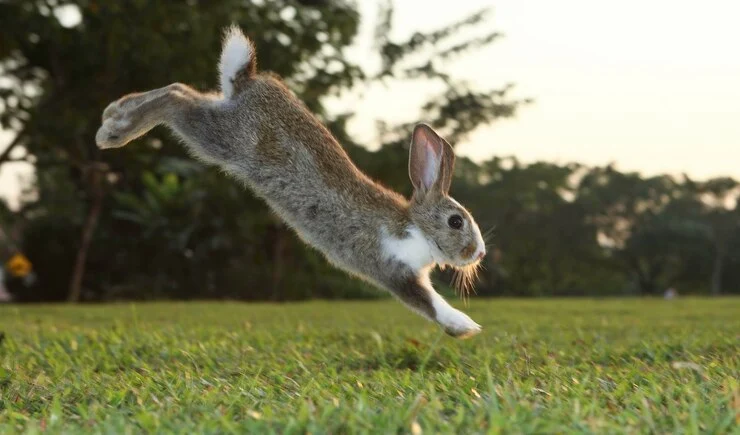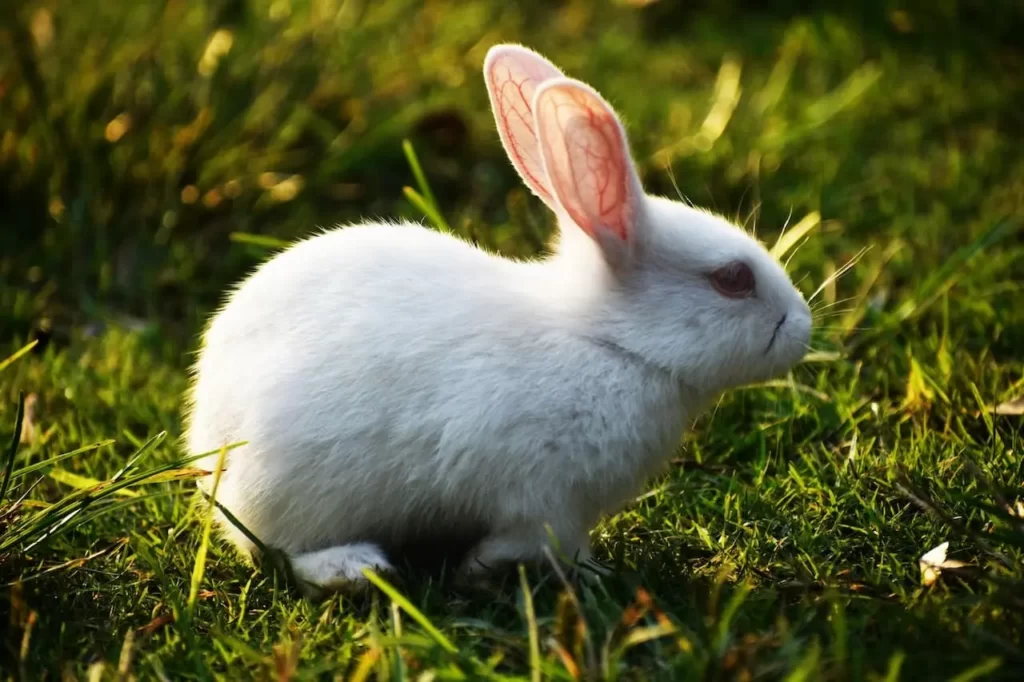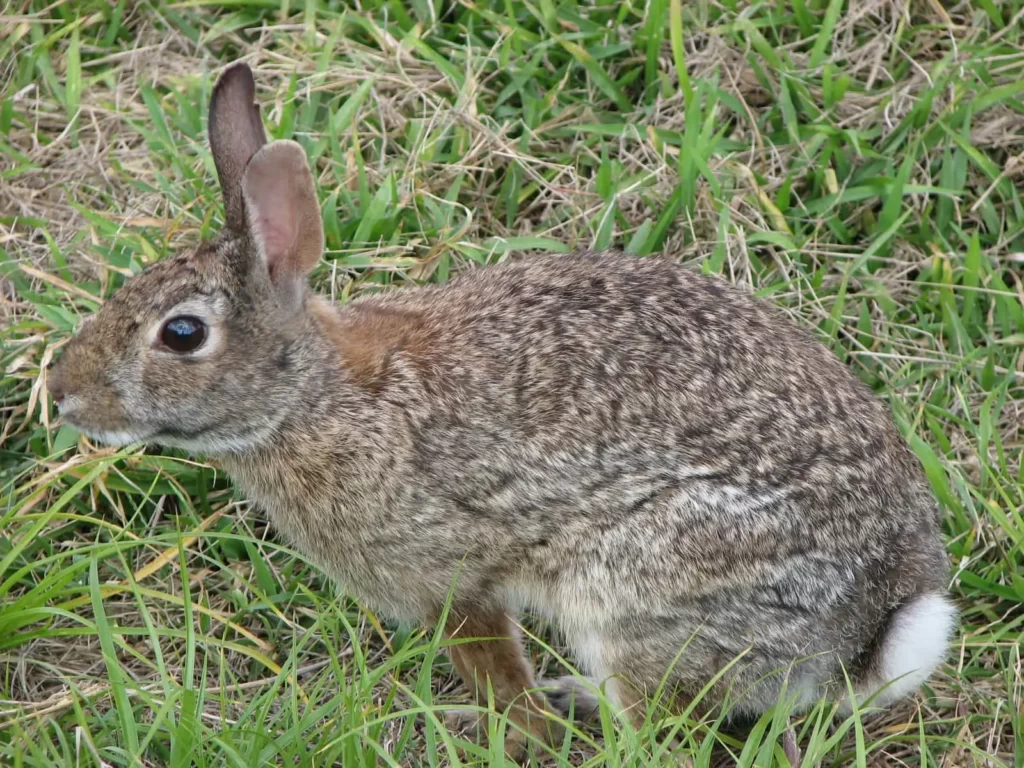How High Can Rabbits Jump?
How High Can Rabbits Jump? It is a common question that is usually asked by rabbit owners.
Rabbits have excellent jumping abilities. They can leap over obstacles and even run on the ground, even though they are small.
In this blog, we learn how high can a rabbit jump, and answer common questions related to rabbits jumping.
So, let’s get started!

How High Can Rabbits Jump?
On average, a healthy adult rabbit can jump anywhere from 1 to 3 feet (30 to 90 centimeters) off the ground.
However, some rabbits have been known to jump even higher under certain circumstances. For instance, if a rabbit feels threatened or scared, it might perform extraordinary jumps to escape potential predators.
Rabbits’ powerful hind legs are their primary means of propulsion, allowing them to leap with such impressive height and distance.
Their jumping skills are not only helpful for escaping danger but also aid them in accessing food sources and navigating their environment, especially in the wild.
Read Also: Can Rabbits Eat Cauliflower

Factors Affecting Rabbit Jumping
There are some factors that affect rabbits jumping abilities. Let’s discuss them!
1. Role of Age and Physical Development in Jumping
Young rabbits might not be as adept at jumping as adults since their muscles and bones are still developing.
As they grow older, their jumping abilities improve. Additionally, older rabbits may experience a decline in jumping prowess due to age-related changes.
2. Role of Breed and Rabbit Size in Jumping
Different rabbit breeds exhibit varying levels of jumping skills. Smaller breeds like Netherland Dwarfs may not jump as high as larger breeds like Flemish Giants. The rabbit’s size and proportions influence its jumping capacity.
3. Health and Fitness Levels
A rabbit’s overall health and fitness directly impact its jumping abilities. A well-nourished and physically active rabbit is more likely to jump higher than a rabbit with health issues or lack of exercise.
Read Also: Can Rabbits Eat Pineapple?
But have you ever wondered why rabbits jump?
Let’s learn!

Why Do Rabbits Jump?
Rabbits jump for various reasons, and their jumping abilities serve several important purposes for their survival and well-being.
Here are some of the main reasons why rabbits jump:
1. Rabbits Hop to Escape Predators
In the wild, rabbits are prey animals, and jumping is a crucial defense mechanism to escape from predators.
When they sense danger or feel threatened, their powerful hind legs allow them to make quick and agile leaps to get away from potential threats.
2. Jumping to Get Food
Rabbits are herbivores, and their natural diet consists of vegetation. Jumping enables them to reach higher and inaccessible food sources, such as leaves, buds, and tender shoots, giving them access to a more varied diet.
3. Rabbits Jump to Explore Their Environment
Rabbits are curious animals, and jumping helps them explore their surroundings more effectively. They can hop over obstacles, navigate rough terrain, and move through dense vegetation, all of which contribute to their ability to find suitable shelter and food.
4. Rabbits Use Jump for Communication and Social Interaction
Rabbits also use jumping as a form of communication and social interaction with other rabbits. During play, they might engage in “binkies,” which are joyful jumps and twists in the air, signaling happiness and contentment.
5. Rabbits Jump to Play
Jumping is a natural and essential form of exercise for rabbits. In captivity, providing opportunities for your pet rabbit to jump and play can help keep them physically active and mentally stimulated, promoting a healthier and happier life.
6. Territorial Displays
In some cases, rabbits might use jumping as part of their territorial displays. This behavior can be seen in wild rabbits during their courtship rituals and in marking their territory to warn other rabbits to stay away.
Overall, jumping is an innate and instinctive behavior for rabbits, deeply rooted in their nature as prey animals.
Whether it’s evading predators, accessing food, exploring, playing, or communicating, this remarkable ability to leap serves as an essential survival skill for these adorable and agile creatures.
Read Also: Can Rabbits See In The Dark?

Can I Teach My Rabbit to Jump?
Absolutely! Rabbits are intelligent and trainable animals, and with patience and positive reinforcement, you can teach them to jump over obstacles.
Training your rabbit to jump can be a fun and rewarding experience for both of you.
Here are some steps to get started:
1. Buil a Bond with Your Rabbit
Before starting any training, it’s essential to build a strong bond with your rabbit. Spend time with them, handle them gently, and offer treats to create a positive association.
2. Choose the Right Rabbit for Jumping Training
Some rabbits are more inclined to be active and enjoy jumping, while others may not be as interested. Choose a rabbit that seems curious and energetic to make the training process smoother.
3. Create a Safe Environment
Set up a safe and comfortable space for training. Make sure there are no hazards or sharp objects that could harm your rabbit. Use soft and lightweight obstacles initially.
4. Use Positive Reinforcement Techniques for Training
Positive reinforcement is key to training rabbits. Reward your rabbit with small treats and lots of praise whenever they jump over an obstacle successfully. This encourages them to repeat the behavior.
5. Start from Low Obstacles
Begin with low obstacles, like a small hurdle made of pillows or soft objects. You can gradually increase the height as your rabbit becomes more comfortable with jumping.
6. Use Targeting for Guidance
You can use a target stick or a treat to guide your rabbit over the obstacle. Place the target above the obstacle to encourage your rabbit to jump over it.
7. Be Patient
Training takes time, and every rabbit learns at its own pace. Be patient and avoid forcing your rabbit to jump if they seem hesitant or scared.
8. Keep Training Sessions Short
Rabbits have short attention spans, so keep training sessions brief and enjoyable. A few minutes of training every day is better than a long session once a week.
9. End on a Positive Note
Always end the training session on a positive note, even if your rabbit didn’t jump as high as you hoped. Celebrate the progress they’ve made.
10. Consult a Veterinarian
Before starting any training, ensure your rabbit is healthy and able to participate in physical activities. If you have any concerns, consult a veterinarian.
Remember, every rabbit is different, and some may take longer to learn than others. Stay patient, be consistent, and most importantly, make the training experience fun for your furry friend!

How to Increase a Rabbit’s Ability to Jump?
A rabbit’s ability to jump depends on its size, age, and weight. The rabbit’s ability to jump is also affected by its lifestyle and environment.
For example, if you put a rabbit in an environment with a lot of open space, it will have more freedom to jump.
On the other hand, if you put a rabbit in an environment that has a lot of concrete and other things that restrict its movement, it will not be able to jump as high.
Let’s discuss some ways to increase the jumping ability of your rabbit.
1. Provide Adequate Space for Jumping
Ensure your rabbit has enough space to move around and exercise. A larger living area allows them to practice jumping and hopping freely, which can help strengthen their leg muscles and improve their jumping skills.
2. Encourage Regular Exercise
Encourage your rabbit to be active by providing opportunities for exercise. Rabbit-proof a safe and secure area where they can explore, hop, and jump. Regular physical activity helps keep their muscles toned and joints flexible.
3. Create a Jumping Course
Design a simple obstacle course using soft and safe materials, such as cardboard boxes or pillows, for your rabbit to jump over.
Gradually increase the height and complexity of the obstacles as your rabbit becomes more comfortable and confident.
4. Use Positive Reinforcement
Positive reinforcement, such as treats, praise, or gentle pets, can motivate your rabbit to jump. Whenever they successfully jump over an obstacle or participate in a jumping activity, reward them with a treat and praise to reinforce the behavior.
5. Offer Mental Stimulation
Mental stimulation is crucial for a rabbit’s overall well-being. Provide toys, tunnels, and puzzle feeders to keep them mentally engaged.
A stimulated mind can lead to increased curiosity and willingness to explore, which may translate into more jumping activity.
6. Consider Agility Training
Some rabbit owners engage their bunnies in agility training, similar to dog agility courses. Introducing simple jumps and obstacles in a controlled environment can be a fun and rewarding experience for both you and your rabbit.
7. Ensure a Balanced Diet
Proper nutrition is essential for your rabbit’s health and energy levels. A well-balanced diet rich in hay, fresh vegetables, and a limited amount of pellets provides the necessary nutrients for a healthy and active rabbit.
8. Do Regular Veterinary Check-ups
Schedule regular check-ups with a rabbit-savvy veterinarian to ensure your pet is in good health. Address any health issues promptly to maintain their physical abilities.
9. Patience and Consistency
Be patient and consistent in your efforts to encourage jumping. Each rabbit learns at its own pace, so be encouraging and avoid forcing them to jump if they are unsure or fearful.

How High Can a Domestic Rabbit Jump?
Domestic rabbits, like their wild counterparts, are also excellent jumpers.
On average, a healthy domestic rabbit can jump anywhere from 1 to 2 feet (30 to 60 centimeters) high.
However, some rabbits may be capable of jumping even higher, depending on their breed, age, physical condition, and individual abilities.
Similar to wild rabbits, domestic rabbits use their powerful hind legs to propel themselves into the air.
They possess the same natural jumping instincts, which they may demonstrate during play, exploration, or to escape perceived threats.

How High Can Wild Rabbits Jump?
Wild rabbits are known for their impressive jumping abilities, which play a crucial role in their survival as prey animals.
On average, a healthy wild rabbit can jump up to 3 to 4 feet (90 to 120 centimeters) high. However, under certain circumstances, some wild rabbits have been observed to clear even higher obstacles.
The height of a rabbit’s jump can vary depending on factors such as their age, physical condition, and the level of threat they perceive.
When trying to escape from predators or other perceived dangers, rabbits can muster remarkable bursts of energy and reach greater heights in their leaps.
In the wild, rabbits use their jumping skills to evade predators, access food sources, and navigate their natural environment, which often includes obstacles such as bushes, rocks, and fallen branches.
Their powerful hind legs, specifically adapted for propulsion, enable them to make quick and agile leaps to escape danger and find shelter.

How High Can a Cottontail Rabbit Jump?
Cottontail rabbits, also known as Eastern cottontail rabbits (Sylvilagus floridanus), are known for their impressive jumping abilities.
On average, a cottontail rabbit can jump up to 15 feet (about 0.6-0.9 meters) high. They use their powerful hind legs to propel themselves upwards when escaping predators or navigating through their environment.
These rabbits have evolved to be agile and quick to avoid danger in the wild. Their ability to jump helps them escape predators and find food.
How High Can a Rabbit Jump Vertically?
On average, a healthy adult rabbit can jump about 4 feet (approximately 120 centimeters) vertically.
However, some rabbits may be capable of jumping even higher, especially if they are highly active and have strong leg muscles. Additionally, certain rabbit breeds might have slightly different jumping capabilities.
How High Can Dwarf Rabbits Jump?
Dwarf rabbits, like other rabbit breeds, are agile and have strong hind legs, but they cannot jump much higher as compared to other rabbits.
Dwarf rabbits can jump up to 1 to 2 feet (approximately 30 to 60 centimeters) vertically.
How High Can a Jack Rabbit Jump?
Jackrabbits are incredibly agile and can jump quite high. A jackrabbit can jump up to 20 feet high.
When they are startled or trying to escape from predators, they can exhibit this impressive leaping ability to quickly clear obstacles and cover large distances in a single bound.
Their powerful hind legs and lightweight bodies are adapted for such high jumps, making them one of the fastest and most agile animals in their habitat.
How High Can a Baby Bunny Jump?
Although baby rabbits can’t jump as high as adults, when they are just a few weeks old and starting to explore their surroundings, they can jump up to 1 to 2 feet high (approximately 30 to 60 centimeters).
How High Does a Rabbit Fence Need to Be?
The height of a rabbit fence depends on several factors, including the size and agility of the rabbits in your area.
Generally, rabbits are skilled at jumping and can easily leap over low barriers. To effectively prevent rabbits from entering a garden or an area, a fence that is at least 2 feet (60 centimeters) high is recommended.
If you’re dealing with larger or more agile rabbit breeds, or if you want to be extra cautious, you may consider a fence that is 3 to 4 feet (90 to 120 centimeters) high. This should be sufficient to deter most rabbits from hopping over.
Additionally, it’s important to ensure that the fence has no gaps or spaces through which the rabbits could squeeze through. A solid fence or one with small gaps (less than 1 inch or 2.5 centimeters) is more effective at keeping rabbits out.
Keep in mind that while height is important, rabbits are also known to dig, so it’s a good idea to extend the fence into the ground or place some form of barrier beneath the ground to prevent burrowing.
Overall, the most effective rabbit fences are often a combination of proper height, solid construction, and consideration of rabbit behaviors to create an effective deterrent.
Read Our Complete Guide: How To Make a Rabbit Nesting Box – Easy DIY
Conclusion
Rabbits are excellent jumpers. Though their jumping capabilities also depend upon, their breeds, size, health, and the environment they are living.
We can also enhance the jumping capabilities of our pet rabbits and train them to jump higher. But we should also select a high jumping breed while training them for jumping as some rabbits like dwarf rabbits can’t jump higher due to their small size.

